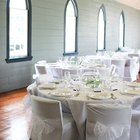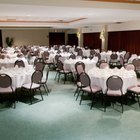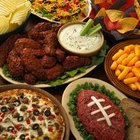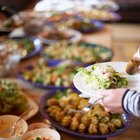
Rodizio is a popular type of restaurant service usually found in Latin America, and particularly in Brazil. In Rodizio-style service, customers do not order food in the traditional manner, nor do they serve themselves from a buffet. Instead, the style is a blend of the two, where an assortment of dishes -- especially meats -- are brought to the table for picking and choosing.
How It Works
Those entering a Rodizio-style restaurant for the first time can find the unusual service a bit confusing. Diners are typically charged a flat fee and menus consist only of side dishes and drinks. Rodizio-style servers walk through the restaurant offering food to diners, who can have as much as they want and signal when they're finished, at which point they pay the flat fee and any extra charges for drinks and side dishes.
Rodizio Style Restaurants
While there are several types of Rodizio-style restaurants, the most popular is the Brazilian churrascaria, which roughly translates to "steakhouse." Churrascarias serve different kinds of grilled meats, and servers travel through the restaurant with hot meat on skewers, slicing it directly onto each diner's plate. Other types may serve pizza, pasta, salad and desserts in Rodizio fashion.
Types of Food
Traditional Rodizio-style restaurants feature many different Brazilian meats and dishes, including filet mignon or chicken wrapped in bacon, sirloin steak, roast beef, seasoned top sirloin known as picahha, beef short ribs, lamb, pork ribs, Portuguese sausages, grilled chicken and chicken hearts. Grilled pineapple and banana are also offered between meat dishes as a palate cleanser. There is usually a buffet that offers different types of rice, potatoes and greens.
Rodizio Cards
In a Rodizio-style restaurant, diners are typically presented with cards as they enter the restaurant. The cards are a different color on each side -- usually red and green or red and black -- and serve two purposes. They're a marker that lets servers know how much the flat fee is for the table. The colored sides also let servers know whether the diner is finished or still wants more meat. Red traditionally indicates "stop," while black or green indicates "more, please."
Related Articles

Ways to Serve Dinner at a Wedding ...

Proper Etiquette for Banquet Food ...

Formal Birthday Party Ideas

Supper for a Crowd With a Baked Potato ...

Ideas for Finger Food for a Wedding ...

How to Organize a Church Bazaar

Inexpensive Finger Foods for a Wedding ...

What Should a Guy Wear to a Banquet?

Tips for Catering a Wedding Reception ...

How to Properly Set Up Banquet Tables

How to Plan a Brunch Menu

How to Display Food Names at a Party

How to Cater Your Own Party

How to Plan a Luncheon

What Is a Bridal Brunch?

How to Plan a Reception With Finger ...

How to Greet a First Date

Cold Buffet Ideas for Weddings

Party Foods for a 2pm Bridal Shower

Tipping Guidelines for Catered Events
Writer Bio
Tom Johnson has served as the lead writer of his copywriting business since 2008. He has extensive backgrounds in psychology and marketing. He holds a Bachelor of Arts in English literature from the University of Guam, and a Level II teaching certification in language arts from the Guam Department of Education.
Photo Credits
Photos.com/Photos.com/Getty Images